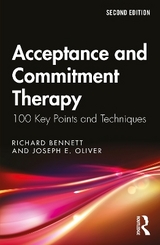
Acceptance and Commitment Therapy
Routledge (Verlag)
978-1-138-48302-6 (ISBN)
Divided into three main parts, the book covers the ‘Head, Hands, and Heart’ of the approach, moving from the basics of behavioural psychology, via the key principles of Relational Frame Theory and the Psychological Flexibility model, to a detailed description of how ACT is practiced, providing the reader with a solid grounding from which to develop their delivery of ACT-consistent interventions. It concludes by addressing key decisions to make in practice and how best to attend to the therapeutic process.
The authors of Acceptance and Commitment Therapy bring a wealth of experience of using ACT in their own therapy practice and of training and supervising others in developing knowledge and skills in the approach. This book will appeal to practitioners looking to further their theoretical knowledge and hands-on skills and those seeking a useful reference for all aspects of their ACT practice.
Richard Bennett works as a Clinical Psychologist and Cognitive Behavioural Psychotherapist and runs a private practice, Think Psychology. He also leads a Postgraduate Diploma in Cognitive Behavioural Therapy as part of the Centre for Applied Psychology at The University of Birmingham. Joseph E. Oliver is a Consultant Clinical Psychologist and director for Contextual Consulting, a consultancy based in London providing ACT training, coaching, and therapy. He is joint director for the University College London Cognitive Behavioural Therapy in Psychosis Post Graduate Diploma, whilst also holding a post within the NHS.
Introduction 1. The Head of ACT – Philosophy and theory Key Behavioural Principles 2. The 'B' in CBT 3. Learning by Association 4. Learning by Consequence 5. Appetitive and Aversive Control 6. Functional Contextualism 7. A Pragmatic Truth 8. The Function of Behaviour 9. Function Versus Form 10. The Importance of Context 11. Learning through Language and Cognition Relational Frame Theory (RFT) 12. Background to RFT 13. Relational Responding 14. Different Ways of Relating 15. Transformation of Stimulus Functions 16. Coherence 17. Language as a Gift and a Curse 18. The Illusion of Control 19. Experiential Avoidance 20. Cognitive Fusion 21. Rule-Governed Behaviour Key processes in ACT 22. The Targets of ACT 23. Psychological Flexibility 24. Discrimination and Tracking 25. Widening Behavioural Repertoires 26. A Focus on Process 27. The Hexaflex Model 28. Contact with the Present Moment 29. Self-as-Context 30. Acceptance 31. Defusion 32. Values 33. Committed Action 34. The Hands of ACT – Technique and practice Assessment and formulation 35. ACT as a Cognitive Behavioural Therapy 36. Experiential Learning 37. The Utility of Metaphor 38. Retaining a Process Focus 39. Open, Aware, and Active 40. Focussed Assessment 41. Creative Hopelessness 42. Workability 43. Sharing the ACT Model 44. Maintenance Cycles 45. Towards and Away Moves 46. The ACT Matrix Techniques for moving ACT processes 47. Contact with the Present Moment Techniques 48. Mindfulness with a small ‘m’ 49. Formal Mindfulness Exercises 50. Self-as-Context Techniques 51. The ‘Sky and the Weather’ Exercise 52. Perspective Taking 53. Acceptance Techniques 54. The ‘Tug of War’ Exercise 55. The ‘Chinese Finger Traps’ Exercise 56. Defusion Techniques 57. "I’m having the thought that…" 58. Physicalizing Exercises 59. Values Techniques 60. The ‘Top Ten Moments’ Exercise 61. An alternative ‘Miracle Question’ 62. Committed Action Techniques 63. The ‘Values, Goals and Actions’ Exercise 64. Exposure and Inhibitory Learning Structuring intervention 65. Structuring a Course of Sessions 66. Structuring a Single Session 67. Using Overarching Metaphors 68. The 'Passengers on the Bus' Exercise 69. The 'Lifeline Steps' Exercise 70. The Heart of ACT - Context, strategy, and process ACT in context 71. Human Suffering is Not a Disease 72. Fundamental Human Requirements 73. Our Clients are Stuck, not Broken 74. The Therapeutic Stance 75. ACT in a Cultural Context 76. ACT and the Medical Model Making decisions in practice 77. Process or Protocol? 78. Using Functional Analysis in Session 79. Functional Analytic Psychotherapy 80. Model, Initiate, Reinforce 81. Promoting Practitioner-Client Co-ordination 82. Doing Over Talking 83. Function Over Form 84. Context Over Content 85. Pragmatism Over Truth 86. Working by Addition 87. Increasing Behaviour Over Reducing Behaviour 88. Values Over Goals 89. Ensuring Values do not Become Rules 90. Targeting metaphors Issues within the therapeutic process 91. When Control and Avoidance Might be Good 92. Self-disclosure 93. Staying Present 94. Awareness of Therapist Fusion 95. Steering Clear of the ‘Fix-it’ Trap 96. Staying with Difficult Emotions 97. Learning to Love Your Self-doubt 98. Modelling the Model 99. The ‘On Track, Off Track’ Exercise 100. Maintaining Fidelity to the Model
| Erscheinungsdatum | 01.04.2019 |
|---|---|
| Reihe/Serie | 100 Key Points |
| Zusatzinfo | 3 Line drawings, black and white |
| Verlagsort | London |
| Sprache | englisch |
| Maße | 129 x 198 mm |
| Gewicht | 280 g |
| Themenwelt | Medizin / Pharmazie ► Medizinische Fachgebiete ► Psychiatrie / Psychotherapie |
| Sozialwissenschaften ► Soziologie | |
| ISBN-10 | 1-138-48302-8 / 1138483028 |
| ISBN-13 | 978-1-138-48302-6 / 9781138483026 |
| Zustand | Neuware |
| Informationen gemäß Produktsicherheitsverordnung (GPSR) | |
| Haben Sie eine Frage zum Produkt? |
aus dem Bereich




